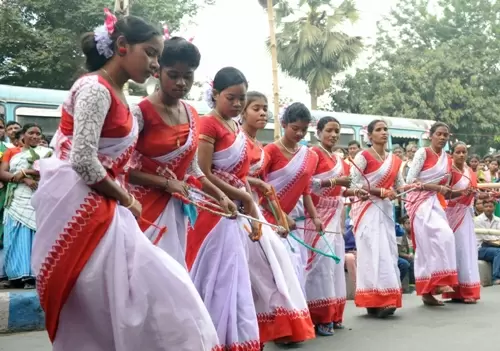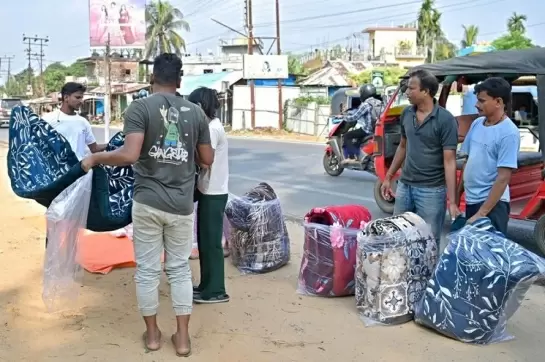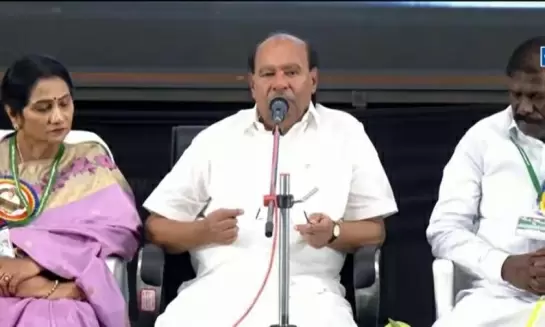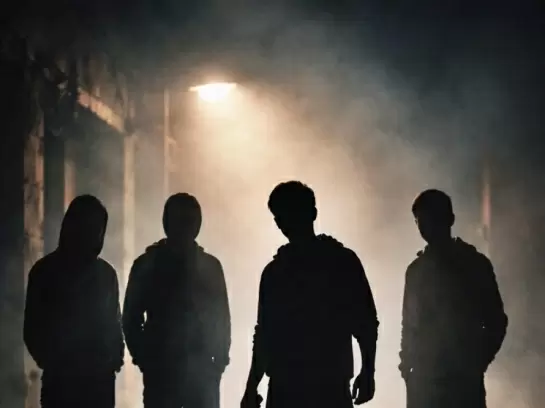‘Why aren't we given any opportunities to make a living?’
07-December-2015
Vol 6 | Issue 49
Sumanti Bhagat, a petite 30-year-old Oraon tribal woman, famous among her tribe for her paintings, uses some sophisticated techniques that could put many contemporary artists to shame.
Bhagat, who has been living in Jaspurnagar since her birth, hand paints on canvases Oraon symbols and images that are unique among her tribe's day-to-day living.
 |
|
Tribal women showcasing their culture at a recent rally in Kolkata (Photo: IANS)
|
Bhagat says simplicity is the key to leading a happy life. She is mostly seen in a white linen red-bordered saree and feathers stuck in her hair. Bhagat feels she is lucky to have a tool in her hand - her art - by which she can know more about the "non-tribal" society.
"Through this art, I am able to visit other places and know more about the world. That is when I know I have very little opportunity to make it big in life. I'm invited for art exhibitions but sometimes paid a mere Rs.500 a day," Bhagat told IANS here, where she was exhibiting her artworks at the recently-concluded Samvaad Tribal Conclave.
Bhagat uses only natural substances for her colours, like rice powder for white, sandstone for red, black soil, limestone for a shade of black and even uses dried cow dung and coal to add other shades to her paintings. All her paintings display grooves, an element that gives them a three-dimensional look and elevates them to a whole new level.
As I complimented her on her techniques, she asked gently, yet firmly: "But why aren't we given any opportunities to make a living? Aren't we a part of this country too?" To which, I stood still as I had no answer to give her.
She said she manages to make Rs.4,000 a month from her art shows. "I don't have too much to spend in my Jasarpurnagar town, but who wouldn't like to earn more to send their kids to better schools," Bhagat humbly asked, mentioning her two children, who are in classes 2nd and 4th.
Very similar was the story of Malika Mannow, a 29-year-old, who lives in a neglected corner of the country - few kilometres from Along town of Arunachal Pradesh.
She lives with her family of five - husband, two children and mother-in-law - and makes a living selling green tea, jute products and some local delicacies like fish and pork pickles.
"Where I live, we majorly deal and procure things through the barter system. Those who grow pulses exchange them for some clothes. But we want to send our kids to study and need money," said Mannow, who showcased the Adi tribe's lifestyle at the conclave.
She said she has started sending her home-made pickle, jute products and tea to other cities to sell them there and make some money. "But we aren't paid as much as a local person in the city would make, selling the same product, even if it’s of lesser quality. It's getting tougher to get an education for our kids," Mannow lamented.
She was making all her efforts, by working with other NGO's and exhibiting her products at exhibitions in other cities, and manages to make just Rs.7,000 a month. Her husband makes some Rs.4,000-Rs.5,000 through wood-cutting.
There were many such stories under just one roof of this tribal conclave. Some displaced by development projects and some who moved to cities looking for a better future but did not always manage to get a job and had to live on the streets for the rest of their lives.
These were men and women not figuring in electoral rolls or possessing an ID card because they live in places where no government official has ever stepped in and because their numbers don't add up to a vote bank.
As the world worries about the Middle East refugee crisis, here are India's own economic and social refugees - still waiting to be recognized by the state.
Aren't these the men and women who need more opportunities to 'Make (a living) in India' than those given to businesses? While many still fight to keep their homes from being destroyed for development, many remain displaced and homeless because of developmental projects.
The question still remains: Development for whom? - IANS















